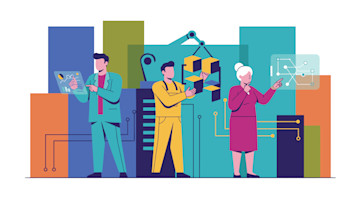Although we hear a lot from economists about what’s going to happen – and trust me, we at AMT have an economic staff and have relationships with some of the leading economists in the world – I’ve got to admit that I am probably more bullish about the outlook for manufacturing in the next three to 10 years than many of the forecasters I’ve heard of late.
For example, consider this from the Department of Defense’s “National Defense Industrial Strategy” report that was published late last year:
“We need to shift from policies rooted in the 20th century that supported a narrow defense industrial base, capitalized on the DOD as the monopsony power, and promoted either/or tradeoffs between cost, speed, and scale. We need to build a modernized industrial ecosystem that includes the traditional defense contractors … and also includes innovative new technology developers; academia; research labs; technical centers; manufacturing centers of excellence; service providers; government-owned, contractor-operated (GOCO) facilities; and finance streams, especially private equity and venture capital.”
What is clear from that passage is a need for existing U.S. manufacturers – including those who have never done work for the DOD – to become involved in bringing capacities, capabilities, and resources to producing the equipment the country needs in an effective and innovative manner.
To put this into some specific context, the U.S. Navy Submarine Industrial Base (SIB) is tasked with building one Columbia-class and two Virginia-class submarines each year for the next decade. The SIB estimates that to accomplish its mission, the two prime shipbuilders and the more than 16,000 suppliers will increase their workload by a factor of five. This means, for one thing, that the suppliers are going to need advanced manufacturing capabilities to accomplish this work. It also means a huge increase in workers to get the job done.
This has led to the creation of the BlueForge Alliance (BFA), a nonprofit that is working to help the industrial base get the manufacturing technologies, workers, and other resources needed for this task. Just to get a sense of how things are being done differently by the BFA, know that its recruiting website, BuildSubmarines.com, is using ZipRecruiter to help workers find jobs and employers workers – certainly not an approach that would have been taken even a few years ago.
And there are other opportunities that are available for manufacturers that aren’t simply based on DOD needs. Consider the growth in sectors ranging from aerospace (e.g., SpaceX, Blue Origin) to urban aircraft (e.g., Archer Aviation, Joby) to non-traditional autos (e.g., Tesla, Lucid). While some of these companies are returning to a strategy of greater vertical integration, they still strongly depend on suppliers. But those suppliers must be ready and responsive in ways that are far from the way things have “always been done.”
What’s more, given the geopolitical situation that exists, including wars in the Middle East and Central Europe, increasing tensions with China, as well as challenges like shipping because of an insufficiency of water in the Panama Canal and missiles in the Gulf of Aden, there is and will continue to be an increase in the amount of manufacturing once done somewhere else in the world returning to the United States.
All of which means there are opportunities for manufacturing companies, but these opportunities don’t come without some costs, as in having the capabilities – in people and technology – necessary to be able to take this work on.
There could be a tendency among some manufacturing managers at companies to position themselves in a way that they think might be appealing to the DOD or a new product producer through bringing in cobots or additive equipment or artificial intelligence or something else that sounds “high tech.”
Don’t get me wrong: I am wholly supportive of companies adding new manufacturing technology – but only if it makes sense. Only if it solves a specific problem or set of problems. Only if it contributes to productivity – and profitability.
Certainly, the top shops in the country have leading-edge technology on their floors. But this equipment was deliberately acquired, installed, and used on a regular basis. It contributes to sales growth and earnings growth.
Yes, getting a contract for a new project may require a capability that a company doesn’t have. But unless that new capability is understood and there’s someone on staff who is able to effectively use it, then it may amount to little more than a capital expense unlikely to be recouped.
There is a lot of work to be done as the country reclaims production that it has lost and rebuilds capabilities that have aged.
There are also the manufacturing technologies that can be used to the advantage of the producer and for the purchaser – if that technology is used to drive productivity and create value.
Admittedly, this can be challenging to assess. So, to that end, this is one of the reasons AMT exists: We offer the ways and means to help you make the necessary technical transition through our events like IMTS, Formnext, and SPS; our MFG Meeting and MTForecast conferences; and our researchers and analysts.
Douglas K. Woods
President
AMT – The Association For Manufacturing Technology
To read the rest of the Additive Issue of MT Magazine, click here.






